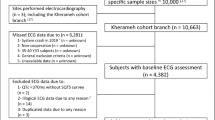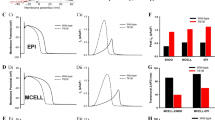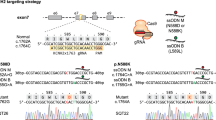Abstract
Short QT syndrome (SQTS) is a genetic arrhythmogenic disease that can cause malignant arrhythmia and sudden cardiac death. The current therapies for SQTS have application restrictions. We previously found that Mg· (NH2CH2CH2SO3)2· H2O, a taurine-magnesium coordination compound (TMCC) exerted anti-arrhythmic effects with low toxicity. In this study we established 3 different models to assess the potential anti-arrhythmic effects of TMCC on type 2 short QT syndrome (SQT2). In Langendorff guinea pig-perfused hearts, perfusion of pinacidil (20 μmol/L) significantly shortened the QT interval and QTpeak and increased rTp-Te (P<0.05 vs control). Subsequently, perfusion of TMCC (1–4 mmol/L) dose-dependently increased the QT interval and QTpeak (P<0.01 vs pinacidil). TMCC perfusion also reversed the rTp-Te value to the normal range. In guinea pig ventricular myocytes, perfusion of trapidil (1 mmol/L) significantly shortened the action potential duration at 50% (APD50) and 90% repolarization (APD90), which was significantly reversed by TMCC (0.01–1 mmol/L, P<0.05 vs trapidil). In HEK293 cells that stably expressed the outward delayed rectifier potassium channels (IKs), perfusion of TMCC (0.01–1 mmol/L) dose-dependently inhibited the IKs current with an IC50 value of 201.1 μmol/L. The present study provides evidence that TMCC can extend the repolarization period and inhibit the repolarizing current, IKs, thereby representing a therapeutic candidate for ventricular arrhythmia in SQT2.
Similar content being viewed by others
Log in or create a free account to read this content
Gain free access to this article, as well as selected content from this journal and more on nature.com
or
References
Gussak I, Brugada P, Brugada J, Wright RS, Kopecky SL, Chaitman BR, et al. Idiopathic short QT interval: a new clinical syndrome? Cardiology 2000; 94: 99–102.
Gaita F, Giustetto C, Bianchi F, Wolpert C, Schimpf R, Riccardi R, et al. Short QT syndrome: a familial cause of sudden death. Circulation 2003; 108: 965–70.
Rudic B, Schimpf R, Borggrefe M . Short QT syndrome–Review of diagnosis and treatment. Arrhyth Electrophysiol Rev 2014; 3: 76–9.
Hong K, Hu J, Yu J, Brugada R . Concomitant Brugada-like and short QT electrocardiogram linked to SCN5A mutation. Eur J Hum Genet 2012; 20: 1189–92.
Cheng TO . Digitalis administration: an underappreciated but common cause of short QT interval. Circulation 2004; 109: e152.
Tavernier R, Jordaens L, Haerynck F, Derycke E, Clement DL . Changes in the QT interval and its adaptation to rate, assessed with continuous electrocardiographic recordings in patients with ventricular fibrillation, as compared to normal individuals without arrhythmias. Eur Heart J 1997; 18: 994–9.
Malik M . Drug-induced QT/QTc interval shortening: lessons from drug-induced QT/QTc prolongation. Drug Safety 2016; 39: 647–59.
Saikawa T, Tsumabuki S, Nakagawa M, Takakura T, Tamura M, Maeda T, et al. QT intervals as an index of high serum calcium in hypercalcemia. Clin Cardiol 1988; 11: 75–8.
Mondoly P, Cardin C, Rollin A, Duparc A, Maury P . Use of a subcutaneous ICD in a patient with short QT syndrome. Clin Case Rep 2016; 4: 35–8.
Patel C, Antzelevitch C . Pharmacological approach to the treatment of long and short QT syndromes. Pharmacol Ther 2008; 118: 138–51.
Schimpf R, Veltmann C, Giustetto C, Gaita F, Borggrefe M, Wolpert C . In vivo effects of mutant HERG K+ channel inhibition by disopyramide in patients with a short QT-1 syndrome: a pilot study. J Cardiovasc Electrophysiol 2007; 18: 1157–60.
Chinushi M, Sato A, Izumi D, Furushima H . Nifekalant enlarged the transmural activation-recovery interval difference as well as the peak-to-end interval on surface ECG in a patient with short-QT syndrome. J Cardiovasc Electrophysiol 2012; 23: 877–80.
Bun SS, Maury P, Giustetto C, Deharo JC . Electrical storm in short-QT syndrome successfully treated with Isoproterenol. J Cardiovasc Electrophysiol 2012; 23: 1028–30.
Bodi I, Franke G, Pantulu ND, Wu K, Perez-Feliz S, Bode C, et al. Differential effects of the beta-adrenoceptor blockers carvedilol and metoprolol on SQT1- and SQT2-mutant channels. J Cardiovasc Electrophysiol 2013; 24: 1163–71.
Milberg P, Tegelkamp R, Osada N, Schimpf R, Wolpert C, Breithardt G, et al. Reduction of dispersion of repolarization and prolongation of postrepolarization refractoriness explain the antiarrhythmic effects of quinidine in a model of short QT syndrome. J Cardiovasc Electrophysiol 2007; 18: 658–64.
Padrini R, Bova S, Cargnelli G, Piovan D, Ferrari M . Effects of pinacidil on guinea-pig isolated perfused heart with particular reference to the proarrhythmic effect. Br J Pharmacol 1992; 105: 715–9.
Koncz I, Gurabi Z, Patocskai B, Panama BK, Szel T, Hu D, et al. Mechanisms underlying the development of the electrocardiographic and arrhythmic manifestations of early repolarization syndrome. J Mol Cell Cardiol 2014; 68: 20–8.
Frommeyer G, Ellermann C, Dechering DG, Kochhauser S, Bogeholz N, Guner F, et al. Ranolazine and vernakalant prevent ventricular arrhythmias in an experimental whole-heart model of short QT syndrome. J Cardiovasc Electrophysiol 2016; 27: 1214–9.
Kijtawornrat A, Panyasing Y, Del Rio C, Hamlin RL . Assessment of ECG interval and restitution parameters in the canine model of short QT syndrome. J Pharmacol Toxicol Methods 2010; 61: 231–7.
Azuma J, Sawamura A, Harada H, Tanimoto T, Morita Y, Sperelakis N, et al. Trapidil stimulation of slow Ca2+ current in cardiac muscle. Eur J Pharmacol 1981; 72: 199–208.
Kotake H, Hisatome I, Miyamoto J, Igawa O, Mashiba H . Electrophysiological effect of trapidil on rabbit sinoatrial node cells. Arch Int Pharmacodyn Ther 1986; 279: 61–71.
Marumoto A, Hasegawa J, Zhang F, Moritani H, Harada T, Sano A, et al. Trapidil enhances the slowly activating delayed rectifier potassium current and suppresses the transient inward current induced by catecholamine in guinea pig ventricular myocytes. J Cardiovasc Pharmacol 2005; 46: 167–76.
Ahmadian M, Dabidi Roshan V, Ashourpore E . Taurine supplementation improves functional capacity, myocardial oxygen consumption, and electrical activity in heart failure. J Dietary Suppl 2017; 14: 422–32.
Standley CA, Batia L, Yueh G . Magnesium sulfate effectively reduces blood pressure in an animal model of preeclampsia. J Matern Fetal Neonatal Med 2006; 19: 171–6.
Zhao L, Lou J, Wu H, Yin Y, Kang Y . Effects of taurine-magnesium coordination compound on ionic channels in rat ventricular myocytes of arrhythmia induced by ouabain. Biol Trace Elem Res 2012; 147: 275–84.
Yin Y, Wen K, Wu Y, Kang Y, Lou J . Inhibition of sodium current by taurine magnesium coordination compound prevents cesium chloride-induced arrhythmias. Biol Trace Elem Res 2012; 146: 192–8.
van der Linde H, Van de Water A, Loots W, Van Deuren B, Lu HR, Van Ammel K, et al. A new method to calculate the beat-to-beat instability of QT duration in drug-induced long QT in anesthetized dogs. J Pharmacol Toxicol Methods 2005; 52: 168–77.
Zhang Z, Zhao L, Zhou Y, Lu X, Wang Z, Wang J, et al. Taurine ameliorated homocysteine-induced H9C2 cardiomyocyte apoptosis by modulating endoplasmic reticulum stress. Apoptosis 2017; 22: 647–61.
Chowdhury S, Sinha K, Banerjee S, Sil PC . Taurine protects cisplatin induced cardiotoxicity by modulating inflammatory and endoplasmic reticulum stress responses. BioFactors 2016; 42: 647–64.
Chen XZ, Tereshchenko LG, Berger RD, Trayanova NA . Arrhythmia risk stratification based on QT interval instability: An intracardiac electrocardiogram study. Heart Rhythm 2013; 10: 875–80.
Sicouri S, Glass A, Ferreiro M, Antzelevitch C . Transseptal dispersion of repolarization and its role in the development of Torsade de Pointes arrhythmias. J Cardiovasc Electrophysiol 2010; 21: 441–7.
Liu T, Brown BS, Wu Y, Antzelevitch C, Kowey PR, Yan GX . Blinded validation of the isolated arterially perfused rabbit ventricular wedge in preclinical assessment of drug-induced proarrhythmias. Heart Rhythm 2006; 3: 948–56.
Bellocq C, van Ginneken AC, Bezzina CR, Alders M, Escande D, Mannens MM, et al. Mutation in the KCNQ1 gene leading to the short QT-interval syndrome. Circulation 2004; 109: 2394–7.
Charpentier F, Merot J, Loussouarn G, Baro I . Delayed rectifier K+ currents and cardiac repolarization. J Mol Cell Cardiol 2010; 48: 37–44.
Hancox JC . Considering ranolazine as a potential treatment for K+ channel linked short QT syndrome. J Cardiovasc Electrophysiol 2016; 27: E5.
Acknowledgements
The authors appreciate the valuable comments from other members of our laboratories. This study was supported by the National Natural Science Foundation of China (No 81373410) and the Youth Project of Tianjin Natural Foundation, China (No 14JCQNJC13700).
Author information
Authors and Affiliations
Corresponding author
Rights and permissions
About this article
Cite this article
An, My., Sun, K., Li, Y. et al. Therapeutic effects of a taurine-magnesium coordination compound on experimental models of type 2 short QT syndrome. Acta Pharmacol Sin 39, 382–392 (2018). https://doi.org/10.1038/aps.2017.86
Received:
Accepted:
Published:
Issue date:
DOI: https://doi.org/10.1038/aps.2017.86



